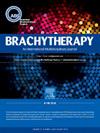Clinical and dosimetric outcomes of a 3-fraction high-dose-rate brachytherapy boost for the treatment of locally advanced cervical cancer in a safety net hospital
IF 1.7
4区 医学
Q4 ONCOLOGY
引用次数: 0
Abstract
PURPOSE
To report outcomes of a 3-fraction HDR brachytherapy boost for the treatment of locally advanced cervical cancer (LACC) at a large safety net hospital.
METHODS AND MATERIALS
A retrospective review of 93 patients with FIGO 2018 Stage IA2 to IVB cervical cancer treated with HDR brachytherapy boost in 3 fractions between 2017 and 2022 was conducted. The 2-year local control (LC), progression-free survival (PFS), and overall survival (OS) was estimated using Kaplan-Meier estimators. Hazard ratios of covariates for local failure (LF) were determined using univariate Cox proportional hazard models.
RESULTS
Median follow-up time was 31 months. Mean cumulative EQD2 of HR-CTV D90 was 85.3 Gy (95% CI 84.2, 86.4). Mean cumulative EQD2 of the D2cc for bladder, rectum, sigmoid, and small bowel was 74.7 Gy (95% CI 72.4, 77.0), 58.2 Gy (95% CI 56.7, 59.6), 60.9 Gy (95% CI 59.4, 62.3), and 58.9 Gy (95% CI 56.7, 61.1) respectively. Two-year LC, PFS, and OS were 80.9% (95% CI 73.1%, 89.5%), 63.2% (95% CI 54.0%, 74.1%), and 85.2% (95% CI 78.1%, 93.0%) respectively. The hazard ratio for LF for incomplete concurrent chemotherapy regimen was 3.07 (95% CI 1.17, 8.09; p = 0.02). Three percent of patients experienced late grade 3+ toxicities after radiation therapy.
CONCLUSIONS
Three-fraction HDR brachytherapy boost was generally well-tolerated by patients and may be a viable alternative in the treatment of LACC.
三段式高剂量率近距离放射治疗在安全网医院治疗局部晚期宫颈癌的临床和剂量学结果
目的:报道在一家大型安全网医院,三段式HDR近距离放疗促进局部晚期宫颈癌(LACC)治疗的结果。方法与材料:回顾性分析2017 - 2022年分3期接受HDR近距离放疗增强治疗的93例FIGO 2018 IA2 ~ IVB期宫颈癌患者。2年局部对照(LC)、无进展生存期(PFS)和总生存期(OS)使用Kaplan-Meier估计器进行估计。局部失效(LF)的协变量风险比采用单变量Cox比例风险模型确定。结果:中位随访时间31个月。HR-CTV D90的平均累积EQD2为85.3 Gy (95% CI 84.2, 86.4)。膀胱、直肠、乙状结肠和小肠D2cc的平均累积EQD2分别为74.7 Gy (95% CI 72.4, 77.0)、58.2 Gy (95% CI 56.7, 59.6)、60.9 Gy (95% CI 59.4, 62.3)和58.9 Gy (95% CI 56.7, 61.1)。两年LC、PFS和OS分别为80.9% (95% CI 73.1%, 89.5%)、63.2% (95% CI 54.0%, 74.1%)和85.2% (95% CI 78.1%, 93.0%)。不完全同步化疗方案发生LF的风险比为3.07 (95% CI 1.17, 8.09; = 0.02页)。3%的患者在放射治疗后出现晚期3+级毒性。结论:三段式HDR近距离强化治疗通常被患者耐受良好,可能是治疗LACC的可行替代方案。
本文章由计算机程序翻译,如有差异,请以英文原文为准。
求助全文
约1分钟内获得全文
求助全文
来源期刊

Brachytherapy
医学-核医学
CiteScore
3.40
自引率
21.10%
发文量
119
审稿时长
9.1 weeks
期刊介绍:
Brachytherapy is an international and multidisciplinary journal that publishes original peer-reviewed articles and selected reviews on the techniques and clinical applications of interstitial and intracavitary radiation in the management of cancers. Laboratory and experimental research relevant to clinical practice is also included. Related disciplines include medical physics, medical oncology, and radiation oncology and radiology. Brachytherapy publishes technical advances, original articles, reviews, and point/counterpoint on controversial issues. Original articles that address any aspect of brachytherapy are invited. Letters to the Editor-in-Chief are encouraged.
 求助内容:
求助内容: 应助结果提醒方式:
应助结果提醒方式:


